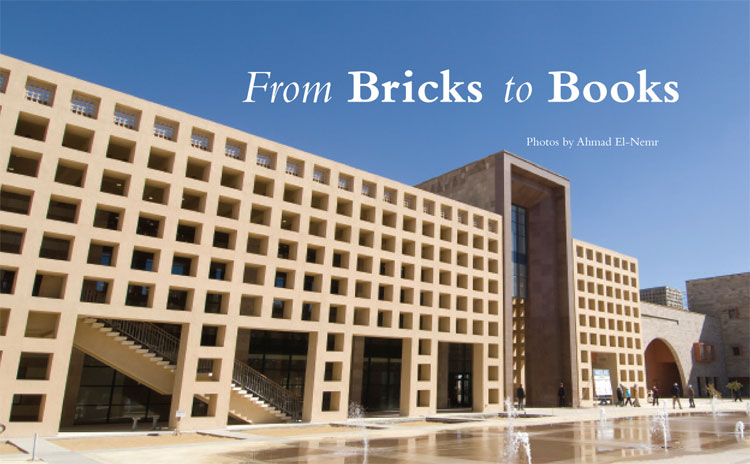The library will be remembered in AUC’s history as the first building to be completed on the new campus.
Standing five stories high, the library is located at the heart of the 260-acre site. Stephen Johnson of Holzman Pfeiffer Associates, the firm that designed the library, described it as the “natural heart of the campus.”
The building’s exterior is made mainly of glass, concrete and sandstone from Aswan. A screen wall with an outer perforated exterior reminiscent of the mashrabeya design provides protection from the sun.
The library occupies a total of 20,550 square meters and overlooks the university garden and Bartlett Plaza. It will be home to a diverse range of facilities, from computer laboratories and modern study rooms to videoconferencing services and advanced research equipment.
The garden level contains the Serenity Room, presented by AUC Trustee Suad Al-Husseini Juffali. It is a reading room overlooking the university garden. There, students will be able to study and read quietly with plenty of natural light. There will also be a data center with the newest technology available for students, faculty and staff.
In addition to the indoor reading room, there is an outdoor reading space in the garden. Students will be able to take library books outside without having to check them out. The space will also be used for special events, and a coffee shop will help make it more inviting.
The plaza level will be home to a multimedia room with high-tech audio and video equipment that can be used for teaching, learning and research. It will also contain the new learning commons, a unique addition to the AUC library. The commons is an area that integrates independent study, interactive learning, multimedia and technology rooms; copy and writing centers; and a library help desk. Students can listen to music, watch a DVD, see a live performance or listen to a speaker while working on their assignments.
“Our students are of a generation that multitasks and drifts between work, leisure and social activities with great ease,” said Pandeli Glavanis, associate director of the Center for Learning and Teaching. “To attract and engage them, the learning commons needs to provide such an environment.”
The next two floors of the library will house more than 400,000 volumes, with room for expansion, as well as open reading spaces, closed carrels for independent study, two large classrooms to serve graduate students and 20 group-study rooms. While the downtown library has few rooms for group work, the new library will allow students to be more interactive in their studies. “The way students learn has changed; people like to work together,” said Shahira El Sawy, dean of libraries and learning technologies. “Learning has changed in the world. It is not enough to just have a lecture. There is teamwork and collective thinking.”
AUC’s Rare Books and Special Collections Library, one of the university’s most esteemed facilities, will be on the top floor and will feature the Mr. and Mrs. C. Stedman Garber, Jr. Garden on the terrace. In addition to the AUC archives, the rare books library holds more than 50,000 books, manuscripts, photographs, slides and maps. Special collections include the Creswell Library of Islamic Art and Architecture, and the collections of Max Debbane, Selim Hassan, Labib Habachi, Mahmoud Saba, Hassan Fathy and Van Leo. The rare books library will also operate a scholarly research and training resource center specializing in the civilizations of ancient, medieval, and modern Egypt and the region.
By Leen Jaber

